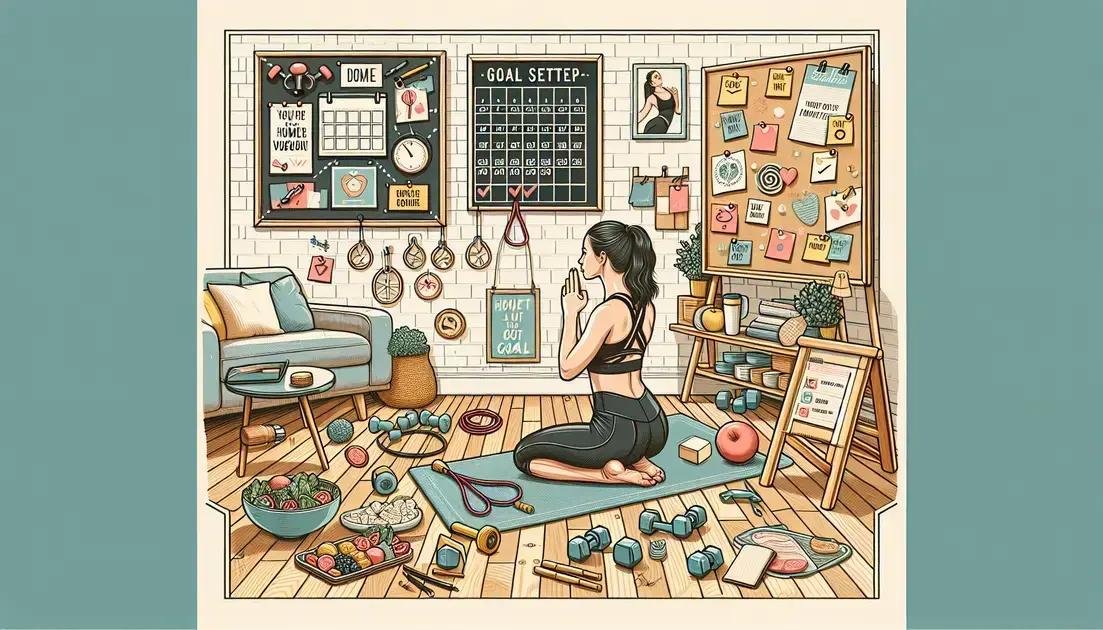
“Kickstart Your Home Workout Routine for Success!”
-
Lucas Souza
-
8, janeiro, 2025
Topics
 Shared
Shared
Starting a home workout routine can be your path to fitness success.
Knowing how to effectively start a successful home workout routine is crucial.
This guide will help you navigate through essential steps to ensure your workouts are productive and enjoyable.
Let’s explore how you can tailor your fitness journey from home with expert tips and practical advice.
Choosing the Right Exercises
Choosing the Right Exercises is essential for your home workout routine. Start by considering your fitness level and preferences. Try exercises that you enjoy, whether it’s strength training, yoga, or high-intensity interval training (HIIT).
To build your routine, include a mix of cardio, strength, and flexibility workouts. Cardio exercises, like jumping jacks or jogging in place, can help improve your heart health. Strength training with bodyweight exercises like squats and push-ups can build muscle.
Moreover, adding flexibility exercises like stretching or yoga can enhance your overall mobility and aid recovery. Listen to your body and adjust your exercise choices to ensure you are both challenged and safe.
Setting Realistic Goals

Setting Realistic Goals is a crucial step in maintaining motivation. Start by identifying what you want to achieve. Make sure your goals are S.M.A.R.T. – Specific, Measurable, Achievable, Relevant, and Time-bound.
For example, instead of saying, ‘I want to get fit,’ a more realistic goal is ‘I want to exercise for 30 minutes, three times a week for the next month.’ This clarity helps you stay focused. Remember to break larger goals into smaller, manageable milestones to track your progress.
Additionally, celebrate small victories along the way. Doing so can maintain your motivation and provide a sense of accomplishment in your fitness journey.
Creating a Workout Schedule
Creating a Workout Schedule is key to a successful home workout routine. Start by deciding how many days a week you can realistically commit to exercising. Aim for at least three to five sessions each week for the best results.
Next, determine the duration of each workout. Aiming for 30 to 60 minutes is ideal, but tailor it to fit your lifestyle and energy levels. Block out specific times in your calendar for workouts, treating them as priority appointments.
Remember to mix different types of workouts throughout the week. For example, you could designate Mondays for strength training, Wednesdays for cardio, and Fridays for flexibility exercises. This approach ensures a well-rounded routine and helps prevent boredom.
Finally, be flexible with your schedule. Life can be unpredictable, so if you miss a workout, simply adjust your schedule. The key is consistency, so find a rhythm that keeps you engaged and motivated.
Essential Equipment for Home Workouts

Essential Equipment for Home Workouts includes a few key items that can enhance your fitness routine. Start with yoga mats, which provide comfort and stability for various exercises.
Dumbbells or resistance bands are valuable for strength training, allowing you to easily adjust weights as you gain strength.
A stability ball can improve your core strength and balance, while jump ropes are excellent for cardio and coordination. If space allows, consider a kettlebell for versatile workout options.
Don’t forget about your water bottle to stay hydrated and a fitness tracker to monitor your progress. By incorporating this equipment into your home workouts, you can effectively target different muscle groups and maintain motivation.
Warm-Up and Cool-Down Routines
Warm-Up and Cool-Down Routines are vital parts of any workout. Starting with a warm-up prepares your body for exercise. Spend 5 to 10 minutes doing light aerobic activities, such as jogging in place or brisk walking. This increases blood flow to your muscles and raises your heart rate.
After warming up, incorporate dynamic stretches like arm circles and leg swings. These movements enhance mobility and help you perform better during your workout. Following your session, a cool-down is equally important. Spend another 5 to 10 minutes performing low-intensity activities, such as walking or gentle cycling, to allow your heart rate to gradually return to normal.
Include static stretching during the cool-down phase. Hold stretches for 15 to 30 seconds, focusing on major muscle groups used during your workout. This helps improve flexibility and reduce muscle stiffness after exercising.
Tracking Your Progress
![]()
Tracking Your Progress is essential for staying motivated in your home workout routine. Begin by setting benchmarks to measure your success, such as the number of workouts completed or weight lifted. Use a fitness journal or an app to record your exercises, duration, and how you feel after each session.
Regularly reviewing your records helps identify patterns and areas for improvement. Consider taking progress photos or body measurements every few weeks to visualize changes. This technique often reinforces your progress more vividly than numbers alone.
Moreover, setting mini-goals can boost motivation. For example, if you aim to run a mile, track how your time improves weekly. This structured tracking makes your fitness journey clear and enjoyable.
Staying Motivated at Home
Staying Motivated at Home can be challenging, but there are effective strategies to keep your spirits high.
Start by creating a dedicated workout space in your home. This space should be inviting and free of distractions, helping to build a positive environment.
Set clear and achievable fitness goals. Break larger goals into smaller, manageable ones. This makes progress easier to see and gives you regular reasons to celebrate.
Consider using a fitness tracker or app to monitor your accomplishments and encourage consistency.
Additionally, find a workout buddy, even if it’s virtual. Connecting with friends or family for workouts can make the experience more enjoyable. You can challenge each other and share progress, which fosters healthy competition.
Lastly, reward yourself for sticking to your routine. Simple rewards, like treating yourself to a movie or new workout gear, can enhance motivation.
Remember, staying motivated is about making your fitness journey enjoyable and sustainable.
Incorporating Variety into Your Routine

Incorporating Variety into Your Routine is essential for keeping your workouts engaging. Doing the same exercises can become monotonous, leading to a loss of motivation.
Start by mixing different types of workouts like cardio, strength training, and flexibility exercises into your week. This not only prevents boredom but also targets different muscle groups, which can enhance your overall fitness.
Consider trying new activities such as dancing, cycling, or hiking. Experiment with group classes available online or apps that offer different styles of workouts. If you love to run, try varying your routes or integrating interval training. This change can make your runs more exciting and effective.
Additionally, switch up the equipment you use. Incorporate tools like dumbbells, resistance bands, or yoga blocks to challenge yourself. Changing your workout environment, like moving from indoors to outdoors, can also provide a fresh perspective and boost motivation.
Importance of Nutrition for Fitness
Importance of Nutrition for Fitness is critical in achieving your health goals. Proper nutrition fuels your body, enhancing performance and recovery.
Begin by incorporating a balanced diet rich in fruits, vegetables, lean proteins, whole grains, and healthy fats.
Carbohydrates are vital for energy, especially before workouts. Foods like oats, bananas, and brown rice can provide sustained energy.
Post-workout, consume protein to aid muscle repair and growth. Options include chicken, fish, beans, or protein shakes.
Staying hydrated is equally important. Aim to drink plenty of water throughout the day, especially before, during, and after exercise. Proper hydration supports overall health and optimizes performance.
Avoiding Common Workout Mistakes

Avoiding Common Workout Mistakes is crucial for ensuring effectiveness in your home workout routine.
One of the biggest errors is skipping the warm-up. Warm-ups prepare your muscles and prevent injuries, so always dedicate at least 5 to 10 minutes to light activities like jogging or dynamic stretches.
Another mistake is using poor form during exercises. This can lead to injuries and inhibit progress. Focus on proper technique, and consider using mirrors or recording yourself to check your form. If unsure, seek guidance from online videos or fitness apps.
Also, avoid pushing yourself too hard, especially as a beginner. Gradually increase intensity and duration to allow your body to adapt.
Lastly, listen to your body. If you feel pain beyond typical soreness, stop the activity to avoid serious injury.
Modifying Workouts for Different Levels
Modifying Workouts for Different Levels is essential to ensure everyone can safely participate in fitness routines.
Begin by assessing your current fitness level. If you are a beginner, start with basic exercises and focus on mastering form before increasing intensity.
For strength training, use lighter weights and fewer repetitions. As you progress, gradually add more weight or increase the number of sets. If you’re more advanced, consider incorporating complex movements or higher resistance to challenge your body further.
Cardio enthusiasts can modify their workouts by adjusting the duration or intensity. Beginners might start with brisk walking, while advanced individuals can try interval training or longer runs.
Always listen to your body, and if a workout feels too difficult or painful, make adjustments to avoid injury.
Rest and Recovery Strategies

Rest and Recovery Strategies are vital for maximizing the benefits of your workouts. After intense exercise, your muscles need time to recover. Aim for at least one to two rest days each week, depending on your workout intensity.
Active recovery is also important. On rest days, consider doing light activities like walking, yoga, or gentle stretching. This keeps blood flowing to the muscles, helping to reduce soreness and stiffness.
Make sure to prioritize sleep. Quality sleep aids recovery and supports overall health. Aim for 7 to 9 hours of sleep each night.
Additionally, proper hydration and nutrition play key roles. Consume enough protein to aid muscle repair and maintain hydration to help your body function effectively.
Conclusion
Starting a successful home workout routine requires careful planning and dedication. By choosing the right exercises and setting realistic goals, you create a strong foundation for your fitness journey.
Incorporating essential equipment, a structured schedule, and a focus on warm-up and cool-down routines can enhance your experience. Remember to track your progress, stay motivated, and introduce variety to keep things exciting.
Nutrition plays a key role, while avoiding common workout mistakes helps ensure safety. Modifying workouts for different fitness levels and prioritizing rest and recovery strategies will optimize your results.
Embrace the journey, and enjoy the process of becoming healthier and stronger.
Frequently Asked Questions about Home Workouts
What should I consider when selecting exercises for my home workout?
Choose exercises based on your fitness level, preferences, and goals. Incorporate a mix of cardio, strength, and flexibility exercises for a balanced routine.
What makes a goal realistic for a home workout routine?
Realistic goals are specific, measurable, achievable, relevant, and time-bound (S.M.A.R.T). Start with small milestones to maintain motivation.
What factors should I consider when creating a workout schedule?
Decide how many days a week you can commit to working out and allocate time for varied activities, ensuring consistency in your routine.
What essential equipment should I invest in for home workouts?
Consider getting a yoga mat, dumbbells, resistance bands, and a stability ball to enhance your workout experience.
What is the purpose of warming up and cooling down?
Warming up prepares your body for exercise, while cooling down helps return your heart rate to normal and aids recovery.
What is the best way to monitor my workout progress?
Keep a fitness journal or use an app to record your workouts, noting exercises completed, duration, and how you feel to track improvements.
What are some strategies to maintain motivation while working out at home?
Set up a dedicated workout space, find a workout buddy, set mini-goals, and reward yourself for reaching milestones to stay motivated.
Why is variety important in my workout routine?
Incorporating variety prevents boredom and helps engage different muscle groups, leading to better overall fitness.
Why is nutrition important for my fitness goals?
Proper nutrition fuels your workouts, aids recovery, and supports overall health, making it important to combine with your exercise routine.
What are the most common mistakes people make when working out?
Common mistakes include skipping warm-ups, using poor form, overtraining, and not listening to your body. Focus on proper technique and gradual progress.
What should I consider when modifying workouts?
Adjust intensity, duration, and complexity of exercises based on your fitness level. Beginners should start with simpler exercises, gradually increasing difficulty.
How can I effectively recover from workouts?
Incorporate rest days, active recovery, good sleep, hydration, and proper nutrition to facilitate muscle recovery and prevent injuries.
 Return blog
Return blog